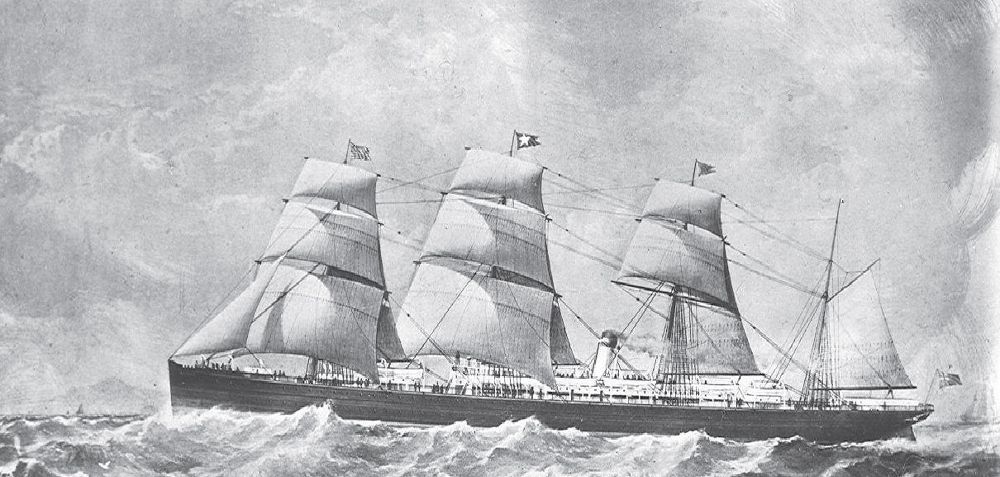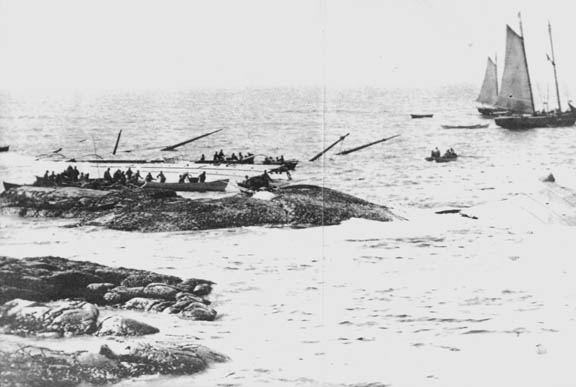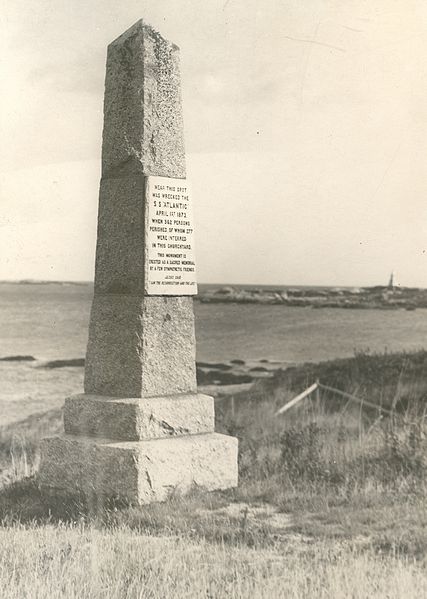SS Atlantic History
The biggest shipwreck in Nova Scotia history, second biggest in Canadian history, and the largest marine disaster in the North Atlantic before the Titanic, occurred on the shores of a picturesque community a half hour's drive from Halifax?
 On the morning of April 1st, 1873, what was the greatest liner of her day crashed upon the shores of Lower Prospect. The SS Atlantic was part of the White Star Line and one of the most modern steamships afloat. She was on her 19th voyage across the Atlantic Ocean, travelling from Liverpool, England to New York. Aboard were some 975 passengers, crew and stowaways, as well as much valuable cargo.
On the morning of April 1st, 1873, what was the greatest liner of her day crashed upon the shores of Lower Prospect. The SS Atlantic was part of the White Star Line and one of the most modern steamships afloat. She was on her 19th voyage across the Atlantic Ocean, travelling from Liverpool, England to New York. Aboard were some 975 passengers, crew and stowaways, as well as much valuable cargo.
On March 31, 1873, his ship was running short of coal and Captain James Williams feared they might not make it to New York, so he diverted to Halifax to refuel.
 Having never been to Halifax, Williams was unaware of the strong currents of the Western Atlantic caused by the 50 foot tides of the Bay of Fundy. He believed the ship to be near Halifax when it was in fact nearly 20 kilometres to the west, near the fishing community of Lower Prospect. At 3:15 A.M. on the 1st of April, 1873, while the captain slept, the Atlantic smashed at full speed into the rocky shores and was wrecked, resulting in the deaths of around 550 people (the exact number has never been established) including all the women and all the children but one.
Having never been to Halifax, Williams was unaware of the strong currents of the Western Atlantic caused by the 50 foot tides of the Bay of Fundy. He believed the ship to be near Halifax when it was in fact nearly 20 kilometres to the west, near the fishing community of Lower Prospect. At 3:15 A.M. on the 1st of April, 1873, while the captain slept, the Atlantic smashed at full speed into the rocky shores and was wrecked, resulting in the deaths of around 550 people (the exact number has never been established) including all the women and all the children but one.
Had it not been for the heroism and bravery of the seaside community, that number would have surely been much larger. The fishermen of Lower Prospect rallied soon after the ship struck a small island. They launched their boats to rescue survivors clinging to life on the wreck of the crippled ship. Meanwhile, the residents of the local communities struggled to care for those that managed to make it to shore.
During the following days as bodies were collected, 277 of those not claimed were interred in St. Paul's Anglican Cemetery and another 150 were buried in the Star of the Sea Roman Catholic Cemetery.
The Ismay family donated the monument pictured below in 1905; Thomas Henry Ismay was the founder of the White Star Line, which owned the SS Atlantic. The monument reads:

Near this spot
was wrecked the
S.S. 'Atlantic'
April 1st, 1873
When 562 persons
perished, of whom 277
were interred
in this church yard.
This monument is
erected as a sacred memorial
by a few sympathetic friends.
Jesus said
'I am the resurrection and the life.'
The monument was lost in overgrown brush and bushes for many years until its rediscovery in 1980. In September of that year, an application for a grant to restore the memorial found in the park, as well as the two burial sites, was sent for approval and the following spring, the restoration was completed. On July 25, 1981, a rededication ceremony was held for the memorial monument and many community members involved proudly attended.
Now, generations after the disaster, the SS Atlantic and its victims are not forgotten. This site is maintained by community volunteers and members of the SS Atlantic Heritage Park Society to keep the memory alive in the community and the province of Nova Scotia.
The biggest shipwreck in Nova Scotia history, second biggest in Canadian history, and the largest marine disaster in the North Atlantic before the Titanic, occurred on the shores of a picturesque community a half hour's drive from Halifax?
 On the morning of April 1st, 1873, what was the greatest liner of her day crashed upon the shores of Lower Prospect. The SS Atlantic was part of the White Star Line and one of the most modern steamships afloat. She was on her 19th voyage across the Atlantic Ocean, travelling from Liverpool, England to New York. Aboard were some 975 passengers, crew and stowaways, as well as much valuable cargo.
On the morning of April 1st, 1873, what was the greatest liner of her day crashed upon the shores of Lower Prospect. The SS Atlantic was part of the White Star Line and one of the most modern steamships afloat. She was on her 19th voyage across the Atlantic Ocean, travelling from Liverpool, England to New York. Aboard were some 975 passengers, crew and stowaways, as well as much valuable cargo.On March 31, 1873, his ship was running short of coal and Captain James Williams feared they might not make it to New York, so he diverted to Halifax to refuel.
 Having never been to Halifax, Williams was unaware of the strong currents of the Western Atlantic caused by the 50 foot tides of the Bay of Fundy. He believed the ship to be near Halifax when it was in fact nearly 20 kilometres to the west, near the fishing community of Lower Prospect. At 3:15 A.M. on the 1st of April, 1873, while the captain slept, the Atlantic smashed at full speed into the rocky shores and was wrecked, resulting in the deaths of around 550 people (the exact number has never been established) including all the women and all the children but one.
Having never been to Halifax, Williams was unaware of the strong currents of the Western Atlantic caused by the 50 foot tides of the Bay of Fundy. He believed the ship to be near Halifax when it was in fact nearly 20 kilometres to the west, near the fishing community of Lower Prospect. At 3:15 A.M. on the 1st of April, 1873, while the captain slept, the Atlantic smashed at full speed into the rocky shores and was wrecked, resulting in the deaths of around 550 people (the exact number has never been established) including all the women and all the children but one.Had it not been for the heroism and bravery of the seaside community, that number would have surely been much larger. The fishermen of Lower Prospect rallied soon after the ship struck a small island. They launched their boats to rescue survivors clinging to life on the wreck of the crippled ship. Meanwhile, the residents of the local communities struggled to care for those that managed to make it to shore.
During the following days as bodies were collected, 277 of those not claimed were interred in St. Paul's Anglican Cemetery and another 150 were buried in the Star of the Sea Roman Catholic Cemetery.
The Ismay family donated the monument pictured below in 1905; Thomas Henry Ismay was the founder of the White Star Line, which owned the SS Atlantic. The monument reads:

Near this spot
was wrecked the
S.S. 'Atlantic'
April 1st, 1873
When 562 persons
perished, of whom 277
were interred
in this church yard.
This monument is
erected as a sacred memorial
by a few sympathetic friends.
Jesus said
'I am the resurrection and the life.'
The monument was lost in overgrown brush and bushes for many years until its rediscovery in 1980. In September of that year, an application for a grant to restore the memorial found in the park, as well as the two burial sites, was sent for approval and the following spring, the restoration was completed. On July 25, 1981, a rededication ceremony was held for the memorial monument and many community members involved proudly attended.
Now, generations after the disaster, the SS Atlantic and its victims are not forgotten. This site is maintained by community volunteers and members of the SS Atlantic Heritage Park Society to keep the memory alive in the community and the province of Nova Scotia.



